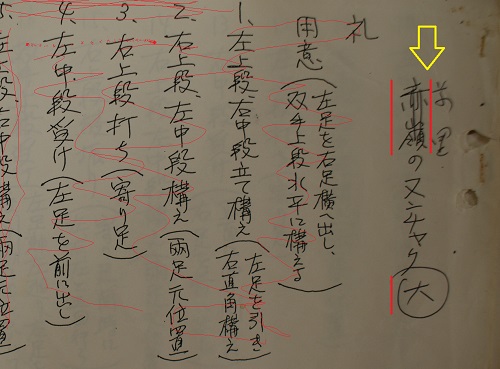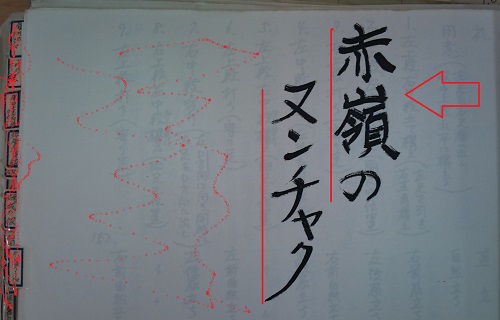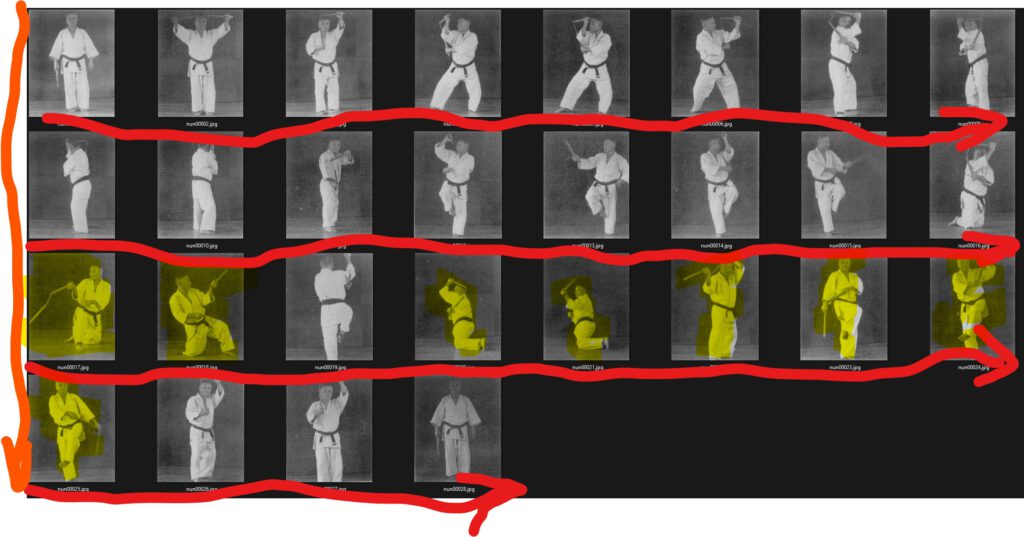In connection with Okinawa karate and kobudō, questions often remain answered unsatisfactorily, or unanswered at all. This may have different reasons. For example, people have long since forgotten what exactly happened several years or decades ago, or they were not even informed at the time, and nobody made any notes about events. When seen as a whole, information from Okinawa is often contradictory, but questions often arise only decades later, such as in the case of the kata called Akamine no Nunchaku.
In 2006, there was the following discussion on Ebudo between Mario McKenna and Tim Jurgens. I very slightly edited the text for consistent use of terminology and better readability.
Mario: “When was Maezato no Nunchaku Dai renamed Akamine no Nunchaku in the Akamine lineage? Was this before or after [Akamine Eisuke’s] passing [in 1999]?”
Tim: “They are different kata with a similar enbusen. We use the Maezato no Nunchaku for 1st Kyū Grading and Akamine no Nunchaku for 1st Dan.”
Mario: “Hi Tim: I know that the two kata have essentially the same enbusen, but they did originally start out as Maezato no Nunchaku Shō and Maezato no Nunchaku Dai. So, as I asked previously, do you know when Maezato no Nunchaku Dai was renamed to Akamine no Nunchaku?”
Tim: “I am unaware of the second kata ever being called Maezato [no Nunchaku Dai]. As you probably know Maezato is Taira Shinken Sensei‘s birth name prior to his adoption. The kata was named after the composer and I was always told that Akamine Eisuke Sensei composed the second kata.”
Mario: “Hello Tim: I guess that we will have to agree to disagree as my instructor (Minowa Katsuhiko) had taught me that both kata were originally called Maezato.”
In short, Minowa Katsuhiko said that Akamine Eisuke taught two nunchaku kata which were originally called Maezato no Nunchaku (Shō) and Maezato no Nunchaku Dai. At some point in time however, the name Maezato no Nunchaku Dai was replaced by the name Akamine no Nunchaku in the Shimbukan dōjō of Akamine Eisuke, now led by his son Akamine Hiroshi. Mario simply asked when this name change happened.
Tim on the other hand maintained that there never has been a kata named Maezato no Nunchaku Dai, but that it was always called Akamine no Nunchaku simply because it was composed by Akamine Eisuke.
Well, as a kobudō person who had studied that lineage and techniques, I know both the kata in question pretty well and for many years. Yesterday, an old colleague who is a well-known and successful German kobudō practitioner contacted me, asking if I knew anything about Maezato no Nunchaku Dai. This is because according to his Okinawan Sensei, the name Maezato no Nunchaku Dai was changed to Akamine no Nunchaku during the latter half of the 1980s in the Shimbukan. In short, some people in Okinawa that have been related to the Shimbukan during the lifetime of Akamine Eisuke indeed maintain that Maezato no Nunchaku Dai existed, and that it was changed to Akamine no Nunchaku.
In short, the name change seems to have taken place 1.) during Akamine Eisuke’s lifetime, and 2. In the latter half of the 1980s. This would answer Mario’s question.
But hold on for a second. Was the kata name really changed? Remember that Tim said that Akamine Eisuke was the creator of the kata, and that he already originally named it Akamine no Nunchaku after his own name.
Well, when I trained for Shimbukan, and with Akamine Hiroshi’s consent, I was able to make various notes, including records of Akamine Eisuke’s kata descriptions. Among them are two descriptions of the two nunchaku kata in question: one original, which must have been written around 1982/83, and one copy, which is newer, maybe from the 1990s or later. See for yourself.
Right: COPY 1990s? Akamine no Nunchaku
In the original, Akamine Eisuke first wrote the kata name as Akamine no Nunchaku. At some later point in time however he crossed out the name Akamine and replaced it by Maezato, and there is also a Dai added in a circle at the end of the name. What does this mean?
It is likely that the kata was actually created by Akamine Eisuke, and obviously he gave it his own name as Akamine no Nunchaku. However, it is presumptuous and unusual to use one’s own name for a self-created kata. This might have been the reason that Akamine Eisuke changed it to Maezato at a later point in time and suffixed Dai to it, making it look as if Taira had created it. In addition to being more nice and less ego centered, the use of Maezato also implies a personal transmission of techniques from Taira to Akamine.
For the sake of completeness: Anyone who knows the two kata is well aware that the second one is based on the first one, and an extension of it. One may well imagine how Akamine Eisuke extended the existing kata a bit to create a second kata. Or in other words, the existing Maezato no Nunchaku served Akamine Eisuke as the template for the creation of Maezato no Nunchaku Dai, AKA Akamine no Nunchaku.
Since some new facts have been established here, let’s continue a bit more. As far as the origin of the older Maezato no Nunchaku (Shō) is concerned, it remains questionable whether Taira’s kata existed in fixed form and was actually passed on personally, or whether Maezato no Nunchaku (Shō) was created after Taira’s passing and simply chosen as a name by his students to indicate a personal tradition. In fact, there is a “nunchaku practice form” described by Taira Shinken himself with photos and all in 1964. This routine has a lot of similarities with Maezato no Nunchaku (Shō), as well as a kneeling technique similar to Maezato no Nunchaku (Dai) [AKA Akamine no Nunchaku], but also contains one entirely different technique not found in any of the others. In short, it seems that Taira worked on developing a nunchaku training routine during the 1950s and 1960s, and either he already created Maezato no Nunchaku (Shō), or his students did so later from whatever they collected and remembered from him.
On another level, we’re talking about developments during the second half of the 20th century. This in turn begs the question: How Ko (ancient) is Okinawa Kobudō (ancient Okinawa martial arts with weaponry) really?
And so, this short study case is a practical example of why questions in Okinawa karate and kobudō often remain unanswered, i.e., because people no longer know exactly what happened several years or decades earlier, and / or they were not even privy to what was happening, and / or because nobody has made any notes about it, and / or ultimately also to underpin and perpetuate the personal tradition from master to student, and / or even to position one’s own name in a genealogy or kata catalogue.
Again, it is unusual for a karate or kobudō person to name a kata with his own name, so why would Taira name a kata with his former family name of Maezato? In terms of budō ethics, this is pretty pretentious. Naming a kata by the name Akamine no Nunchaku, as can be seen in Akamine Eisuke’s original writing of 1982/83, is equally pretentious and the recognition of this ethical problem was probably what led him to correct it to Maezato no Nunchaku Dai.
In the unwritten rules of Okinawan karate historiography however, there is a mechanism that may best be referred to as the “protection of the tradition.” It means that everything has to be explained in an ethical logic. Therefore, as I was told recently, as of now the official story is that around the 2nd half of the 1980s, Akamine Eisuke’s students begged him to name the kata by the name Akamine no Nunchaku, and ultimately he complied with their request.
In Okinawa Karateology, there are many events similar to the above and the quantity of incoherencies and unanswered questions is growing while those who might be able to answer die out. Since it is a pretty boring and difficult matter, young masters prefer to write their own new narratives, create new techniques, draw new genealogies with the help of some seniors who once did the same, and to train their students in the gym and all over the world. And so, there is in fact nothing new under heaven.
© 2023, Andreas Quast. All rights reserved.



